| |
|
Xiamen Oil Paintings, Wholesale Direct!
|
|
100% hand painted, 100% cotton canvas, 100% money back if not satisfaction. |
|
|
|
|
ART WORKS INDEX
A
B
C
D
E
F
G
H
I
J
K
L
M
N
O
P
Q
R
S
T
U
V
W
X
Y
Z
|
|
ARTISTS INDEX
A
B
C
D
E
F
G
H
I
J
K
L
M
N
O
P
Q
R
S
T
U
V
W
X
Y
Z
|
|
|
|
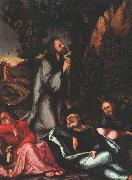 |
Hans Leonhard Schaeufelein
|
|
1480-1540
German
Hans Leonhard Schaeufelein Gallery
Hans Leonhard Schäufelein (c. 1480 ?C 1540) was a German painter, designer, and wood engraver.
He was born in Nuremberg, probably studied under Wohlgemut, and then became the assistant of Durer, whom he imitated. In 1512 he went to Augsburg and in 1515 removed to Nordlingen.
He is a graceful narrator, and his types, though rarely accurately drawn, are attractive, but he lacks power and depth. Characteristic early paintings are the altarpiece at Ober Sankt Veit, near Vienna (1502), "Scenes from the Life of Christ" (Dresden Gallery), and "St. Jerome" (Germanic Museum, Nuremberg).
To his Nordlingen period belong his masterpiece, the so-called "Ziegler Altar" for St. George's Church (1521), part of which is still in the church, part in the museum; "Scenes from the Story of Judith," in the town hall; and the illuminated Psalter for Count von Ottingen, now in the Berlin print room. His most important woodcuts are those for the Theuerdank of Emperor Maximilian.
Schäufelein created a playing card deck about 1535, which is regarded as a highlight in German 16th century playing card production.
|
|
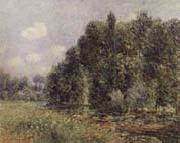 |
Gustave Loiseau
|
|
French, 1865-1935
French painter. He was apprenticed first to a butcher and in 1880 to a house painter. It was not until 1887, when he received a small inheritance, that he was able to devote himself to painting. He spent a year studying modelling and design at the Ecole des Arts D?coratifs in Paris and then entered the studio of the French landscape painter Fernand Just Quignon (b 1854) for six months in 1889. After settling in 1890 in Pont-Aven in Brittany, where he met the painters Maxime Maufra and Henri Moret (1856-1913), he produced such carefully executed works as the Green Rocks (1893; Geneva, Petit Pal.). It was not until 1894, however, that he met Gauguin on the latter return from Tahiti, and though he did not accept Gauguin synthetist ideas the encounter led to a stronger structure and freer brushstrokes in his subsequent work.
|
|
|
|
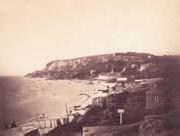 |
Gustave Le Gray
|
|
French Photographer, 1820-1884,French photographer, painter and teacher. He studied painting with Paul Delaroche until 1843. A study trip to Switzerland and Italy, financed by his parents, followed, but it was cut short by an untimely marriage in 1844, his sudden return to his family's home and the subsequent birth of two children in 1845 and 1846. Skilled in painting as an experimenter with pigments, he was attracted to the experimental side of the new paper negative processes available in France after 1847 and plunged into photography, probably to finance the burdens of the family life newly thrust upon him. His treatise, Trait? pratique de photographie sur papier et sur verre (1850), outlined his own variant of the dry waxed paper negative process using thinner paper, as well as a recipe for collodion on glass negatives rivalling that of the English inventor Frederick Scott Archer (see PHOTOGRAPHY,
|
|
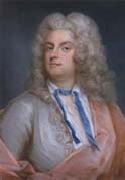 |
Gustaf Lundberg
|
|
Swedish, 1695-1786,Swedish painter and pastellist. He was orphaned early and brought up by his grandfather, the goldsmith Fredrik Richter (1636-1714). In 1710 he was briefly apprenticed to David von Krafft (1655-1724). Against von Krafft's advice, and at his own expense, he travelled to Paris in 1717. He studied first with Hyacinthe Rigaud, Nicolas de Largillierre and Jean-Fran?ois de Troy, learning to paint in a R?gence style less heavy and serious than that taught by von Krafft in Sweden. He also studied drawing under Pierre-Jacques Cazes at the Ecole des Beaux-Arts. In 1720 Rosalba Carriera came to Paris from Italy, bringing with her the fashionable technique of drawing in pastel chalks. Lundberg became her pupil and within a year had mastered the medium, charming the Parisians with his portraits. Until the arrival of Carriera, he had worked only in oils (e.g. the portrait of Gabriel Sack and his Wife Eva Bielke, 1730; priv. col.), but he now turned exclusively to pastels. He received portrait commissions from Louis XV (reg 1715-74), notably for those of his young queen Maria Leszczynska and of her parents Stanislav I Leszczynski and Catherine Opalinska (both 1725; Upplands Vesby, priv. col.), who at that time were living at Chambord. Through the agency of Carl Gustav Tessin, Lundberg was received (re?u) at the Acad?mie Royale de Peinture et de Sculpture in 1741. As his morceaux de reception he executed two portraits of Fran?ois Boucher and Charles-Joseph Nattier, shown at the Salon of 1743.
|
|
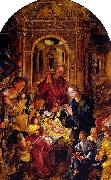 |
Gregorio Lopes
|
|
Gregorio Lopes (c. 1490 - 1550) was one of the most important Renaissance painters from Portugal.
Gregorio Lopes was educated in the workshop of Jorge Afonso, the court painter of King Manuel I. Later he himself became court painter for both Manuel I and for his successor, John III. In 1514 he married the daughter of Jorge Afonso, and in 1520 was knighted by Prince Jorge de Lencastre and entered the Order of Santiago.
The work of Gregorio Lopes mainly consists of painted religious altarpieces for various churches and monasteries in central Portugal. Between 1520 and 1525 he worked (together with Jorge Leal) in painting altarpieces for the Saint Francis Convent of Lisbon. Also in the 1520s he painted panels for the Church of Paraeso (Paradise), also in Lisbon. In his first fase, Gregorio Lopes also worked in Sesimbra, Setebal and in the Monastery of Ferreirim, in this latter case together with Cristevao de Figueiredo and Garcia Fernandes.
The painter moved in the 1530s to the city of Tomar, where he painted various panels for the Round Church of the Convent of Christ (1536 - 1539) and the main altarpiece of the Church of Saint John the Baptist (1538 - 1539). His last known works include altarpieces for the Convent of Santos-o-Novo in Lisbon (1540) and the Valverde Convent, near Évora (1545).
|
|
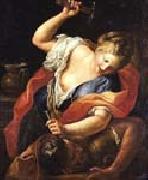 |
Gregorio Lazzarini
|
|
(1657 - 10 November 1730) was an Italian painter, mostly of religious subjects, and those from history and mythology.
Born in Venice, he initially trained with the Genovese painter Francesco Rosa, Girolamo Forabosco, and with the studio of Pietro della Vecchia. He joined the painters' guild in Venice in 1687.
|
|
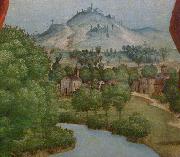 |
Girolamo dai Libri
|
|
(1474/1475 - July 2, 1555) was an Italian illuminator of manuscripts and painter of altarpieces, working in an early-Renaissance style.
He was born and mainly active in Verona. His father was Francesco dai Libri, and was so named because he was an illuminator of books. Girolamo's works were noted by Giorgio Vasari. Girolamo was a pupil of Domenico Morone. Dai Libri painted his first altarpiece, a Deposition from the Cross for Santa Maria in Organo in Verona, at the age of sixteen.
|
|
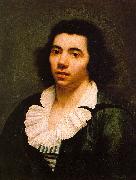 |
Girodet-Trioson, Anne-Louis
|
|
French Neoclassical Painter, 1767-1824
French painter. Originally named Girodet de Roussy or Roucy, he was a student of J.-L. David, and his classical training was sometimes at variance with his often eccentrically romantic expression. He won the Prix de Rome and while in Italy painted the Sleep of Endymion (1791; Louvre), a sensual and erotically ambiguous work that brought him widespread recognition. His Deluge (Louvre) demonstrates Girodet's interest in unusual color and lighting problems. Much of his work, including a series for Malmaison (Napoleon's residence), glorifies Napoleon.
|
|
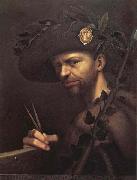 |
Giovanni Paolo Lomazzo
|
|
1538 - 1600
was an Italian painter, belonging to the second generation that produced Mannerism in Italian art and architecture. Gian Paolo Lomazzo was born in Milan from a family emigrated from the town of Lomazzo. His early training was with Giovan Battista della Cerva in Milan. He painted a large Allegory of the Lenten Feast for San Agostino in Piacenza (1567). He also painted an elaborate dome with Glory of Angels for the Capella Foppa in San Marco in Milan. He also painted the Fall of Simon Magus in the wall of the chapel. Lomazzo became blind in 1571, and turning to writing, produced two complex treatises that are milestones in the development of art criticism. His first work, Trattato dell'arte della pittura, scoltura et architettura (1584) is in part a guide to contemporary concepts of decorum, which the Renaissance inherited in part from Antiquity, which controlled a consonance between the functions of interiors and the kinds of painted and sculpted decors that would be suitable; Lespingola offered a systematic codification of esthetics that typifies the increasingly formalized and academic approaches typical of the later sixteenth century. His less practical and more metaphysical Idea del tempio della pittura ("The ideal temple of painting", 1590) offers a description along the lines of the "four temperaments" theory of the human nature and personality,
|
|
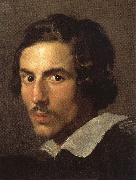 |
Giovanni Lorenzo Bernini
|
|
Italian Baroque sculptor, painter and architect.1598-1680
was a pre-eminent Baroque sculptor and architect of 17th Century Rome. Bernini was born in Naples to a Mannerist sculptor, Pietro Bernini, originally from Florence. At the age of seven he accompanied his father to Rome, where his father was involved in several high profile projects. There as a boy, his skill was soon noticed by the painter Annibale Carracci and by Pope Paul V, and Bernini gained the patronage exclusively under Cardinal Scipione Borghese, the pope's nephew.
|
|
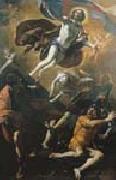 |
Giovanni Lanfranco
|
|
(26 January 1582 - 30 November 1647) was an Italian painter of the Baroque period.
Giovanni Gaspare Lanfranco was born in Parma, the third son of Stefano and Cornelia Lanfranchi, and was placed as a page in the household of Count Orazio Scotti His talent for drawing allowed him to begin an apprenticeship with the Bolognese artist Agostino Carracci, brother of Annibale Carracci, working alongside fellow Parmese Sisto Badalocchio in the local Farnese palaces. When Agostino died in 1602, both young artists moved to Annibale's large and prominent Roman workshop, which was then involved in working on the Galleria Farnese in the Palazzo Farnese gallery ceiling.
|
|
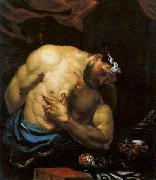 |
Giovanni Battista Langetti
|
|
Giovanni Battista Langetti (1625 - 1676), also known as Giambattista Langetti, was an Italian late-Baroque painter. He was active in his native Genoa, then Rome, and finally for the longest period in Venice.
He first trained with Assereto, then Pietro da Cortona, but afterwards studied under Giovanni Francesco Cassana, appeared in Venice by 1650s were he worked in a striking Caravaggesque style. He is thought to have influenced Johann Karl Loth and Antonio Zanchi. He painted many historical busts for private patrons in the Venetian territory and in Lombardy. He died at Venice in 1676.
|
|
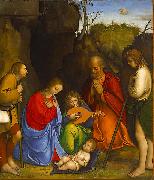 |
Giovanni Agostino da Lodi
|
|
was an Italian painter who was active from c. 1495 to c. 1525.
The attribution of his works has been dubious for centuries, until his style and career was defined by the American art historian Bernard Berenson in the 1960s. One of his first identified work is the Pala dei Barcaioli ("Boatmen Altarpiece") in the church of San Pietro Martire at Murano. His only signed work is the St. Peter and St. John the Evangelist in the Pinacoteca di Brera, which shows Lombard influeces, such as that of Bramantino.
Later he was also influenced by Leonardo da Vinci's style, as visible in the Christ Washing the Feet of the Apostles in the Gallerie dell'Accademia of Venice. After moving to Venice in the wake of Ludovico Sforza's fall, he returned to Milan in 1506. He subsequently executed works for privates and for the Certosa di Pavia; one of his late works, the Calvary, is housed in the National Gallery in Prague. He also collaborated with Marco d'Oggiono for a polyptych in the church of Santa Maria della Pace in Milan, some panels of which are now in the Pinacoteca di Brera.
|
|
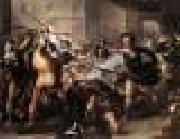 |
GIORDANO, Luca
|
|
Italian Baroque Era Painter, ca.1634-1705
,Italian painter and draughtsman, active also in Spain. He was one of the most celebrated artists of the Neapolitan Baroque, whose vast output included altarpieces, mythological paintings and many decorative fresco cycles in both palaces and churches. He moved away from the dark manner of early 17th-century Neapolitan art as practised by Caravaggio and his followers and Jusepe de Ribera, and, drawing on the ideas of many other artists, above all the 16th-century Venetians and Pietro da Cortona, he introduced a new sense of light and glowing colour, of movement and dramatic action.
|
|
 |
Gijsbrecht Leytens
|
|
(1586-1643 or 1656), also known as The Master of the Winter Landscapes, was a Flemish Baroque painter who specialized in winter landscapes influenced by Jan Brueghel the Elder and Gillis van Coninxloo. He became a master in Antwerp's guild of St. Luke in 1611, but little else is known of his career. Like his contemporaries in Antwerp, Abraham Govaerts and Alexander Keirincx, Leytens painted wooded landscapes populated with small figures, bracketed by strong repoussoir trees. His paintings, however, were generally winter scenes, a recognized specialty known as a Winterken ("little winter").
|
|
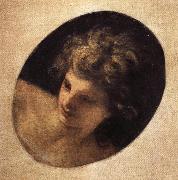 |
Gian Lorenzo Bernini
|
|
Italian sculptor , b. 1598, Napoli, d. 1680, Roma
,Italian architect and artist credited with creating the Baroque style of sculpture. He began his career working for his father, a sculptor. Among his early sculptures are Apollo and Daphne (1622 -C 24) and an active David (1623 -C 24). Under the patronage of Urban VIII, the first of eight popes he was to serve, he created the baldachin over the tomb of St. Peter in Rome. Bernini's architectural duties increased after 1629, when he was appointed architect of St. Peter's Basilica and the Palazzo Barberini. His works often represent a fusion of architecture and sculpture, as in the Cornaro Chapel, in Santa Maria della Vittoria, Rome, with its celebrated theatrical sculpture, The Ecstasy of St. Teresa (1645 C 52). His greatest architectural achievement is the colonnade enclosing the piazza before St. Peter's.
|
|
|
|
|
|
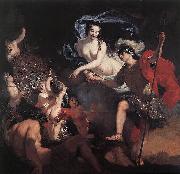 |
Gerard de Lairesse
|
|
Gerard or Gerard de Lairesse (11 September 1640 or 1641 - June 1711) was a Dutch Golden Age painter and art theorist.
Lairesse was born in Liege. His broad range of talent included music, poetry, and the theatre. He was perhaps the most celebrated Dutch painter in the period following the death of Rembrandt. His treatises on painting and drawing, Grondlegginge der teekenkonst (1701) and Groot Schilderboek (1707), were highly influential on 18th-Century painters like Jacob de Wit. Students of De Lairesse included the painter Jan van Mieris. He died in Amsterdam.
|
|
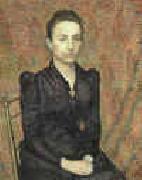 |
Georges Lemmen
|
|
1865-1916
French
Georges Lemmen Gallery
Belgian painter and decorative artist. He showed a precocious talent, first exhibiting in 1875. His only formal study was at a local school of drawing. Between 1884 and 1886 he showed at the Essor group in Brussels paintings that were based on D?rer and Holbein and closely related to those of Lemmen's contemporary, Khnopff. When Lemmen became a member of Les XX in 1888 his style developed quickly, influenced principally by French Neo-Impressionism and the English Arts and Crafts Movement. Lemmen adopted the pointillist technique following Seurat's first showing with Les XX in 1887. His best pointillist canvases include The Carousel (1890-91; Toulon, Mme Thevenin-Lemmen priv. col., see Belgian Art, 1880-1914, exh. cat., New York, Brooklyn Mus., 1980, p. 118, fig. 47) as well as portraits of Julie (1891; Chicago, IL, A. Inst.) and Mme Lemmen (1894-5; Paris, Mus. d'Orsay).
|
|
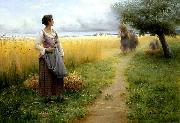 |
Georges Laugee
|
|
Georges Laugee was born in Montivilliers on December 19, 1853. His father, Desire Laugee, was an important French Realist artist; a contemporary of Jules Breton and specialized in portraying the workers in the field. Georges received his early training with his father and then, like many artists of his time, continued his studies at le Ecole des Beaux-Arts. There he studied at the ateliers of Isidore Pils and Henri Lehmann where he mastered the art of life studies and sketching.
In 1877 he made his debut at the Paris Salon and in 1881 was awarded the bronze medal for his Salon entries of that year: En Octobre and Pauvre aveugle. Following his love of nature and the farm worker, Laugee focused on scenes of everyday life. His works, often featuring the peasants tending their animals or working in the fields, are filled with light and realism.
Among the works that Georges chose to exhibit at the Paris Salons were; his 1890 submissions Le Repos and Le Retour des Champs; 1897 submission Sous leaverse (In the Storm) and his 1904 works Deux Amies and Au Temps des bles murs, which portrayed peasant girls in the country. At the Salon of 1906 he exhibited Soleil Couchant (Sunset) and Heure doree (Golden Hour) and continued to exhibit works of similar subject matter through 1928.
In 1889 he participated in the Exposition Universelle, where he received a bronze medal and in the Exposition Universelle of 1900 was awarded the silver medal for his painting entitled Au printemps de la vie (In the Springtime). From 1907 -- 1909 Laugee was a Membre du Comite de la Societe des Artistes Français and was a member of the Jury at the Salon from 1908 -- 1910.
Laugee painting entitled The Favorite. exhibited at the Paris Salon of 1891 and a very similar composition to Bergere et Mouton (featured below) - was illustrated in Famous Paintings of the World, published in 1894. The accompanying caption reads as follows:
In every family, however impartial the parents try to feel, there is always one child for whom, could she bring herself to confess it, the mother has a place in her heart a little warmer than she keeps for any other. The little shepherdess in this charming picture is exemplifying this universal truth of human nature, in her quiet encouragement of the approaches of the favorite lamb of her little flock. This is the pet lamb that she helps over all the stony places, and with which she shares even her own frugal meal. It is a simple story the artist has chosen to tell; but he has set it in a scene of tender and idyllic beauty, thoroughly appropriate to the gentle theme of affection he has selected for the central thought. He has contrasted effectively the simplicity of the shaded hillside nook, speckled with daisies and peopled with the inoffensive flock, and the ripe, full glory of the day, resplendent in the high-banked clouds, and reflected from the still surface of the breezeless summer lake. The photograph reproduction of this canvas has very successfully preserved the painty qualities of the original, so completely transferring to the engraving the technique of the artist that it is impossible that this should be anything other than what it is -- a direct engraving from a masterly painting in oil colors.
Laugee first atelier, located at 20, boulevard Flandrin, Paris, was also the home of the great realist artist Julien Dupre brother-in-law) and just after Dupre death in 1910, Laugee moved to 23, boulevard Lannes. By 1923 he had relocated to 123, Rue de la Tour; where it appears that he remained for the rest of his life.
|
|
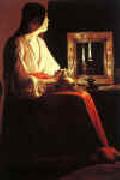 |
Georges de La Tour
|
|
1593-1652
French
Georges de La Tour Galleries
His early work shows influences from Caravaggio, probably via his Dutch followers, and the genre scenes of cheats??as in The Fortune Teller ??and fighting beggars clearly derive from the Dutch Caravaggisti, and probably also his fellow-Lorrainer, Jacques Bellange. These are believed to date from relatively early in his career.
La Tour is best known for the nocturnal light effects which he developed much further than his artistic predecessors had done, and transferred their use in the genre subjects in the paintings of the Dutch Caravaggisti to religious painting in his. Unlike Caravaggio his religious paintings lack dramatic effects. He painted these in a second phase of his style, perhaps beginning in the 1640s, using chiaroscuro, careful geometrical compositions, and very simplified painting of forms. His work moves during his career towards greater simplicity and stillness ?? taking from Caravaggio very different qualities than Jusepe de Ribera and his Tenebrist followers did.
He often painted several variations on the same subjects, and his surviving output is relatively small. His son Etienne was his pupil, and distinguishing between their work in versions of La Tour's compositions is difficult. The version of the Education of the Virgin, in the Frick Collection in New York is an example, as the Museum itself admits. Another group of paintings (example left), of great skill but claimed to be different in style to those of de La Tour, have been attributed to an unknown "Hurdy-gurdy Master". All show older male figures (one group in Malibu includes a female), mostly solitary, either beggars or saints.
After his death in 1652, La Tour's work was largely forgotten until rediscovered by Hermann Voss, a German scholar, in 1915. In 1935 an exhibition in Paris began the revival in interest among a wider public. In the twentieth century a number of his works were identified once more, and forgers tried to help meet the new demand; many aspects of his œuvre remain controversial among art historians.
|
|
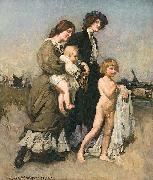 |
George Washington Lambert
|
|
(13 September 1873 - 29 May 1930) was an Australian artist, known principally for portrait paintings and as a war artist during the First World War.
Lambert was born in St Petersburg, Russia, the posthumous son of George Washington Lambert (1833 - 25 July 1873, in London) of Baltimore, Maryland. The younger Lambert's mother was Annie Matilda, nee Firth, an Englishwoman. Mother and son soon moved to Werttemberg, Germany, to be with Lambert's maternal grandfather. Lambert was educated at Kingston College, Yeovil, Somerset. The family, consisting of Lambert, his mother and three sisters, decided to emigrate to Australia. They arrived in Sydney aboard the Bengal on 20 January 1887.
|
|
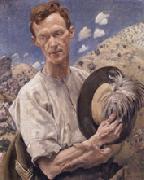 |
George W.Lambert
|
|
Russia-born Australian portrait painter
1873 - 1930
Australian painter, draughtsman and sculptor. He lived for a period in Europe and emigrated to Australia in 1887. He trained under Julian Rossi Ashton, gaining early recognition for his draughtsmanship. In 1901 he studied in Paris at the Acad?mie Colarossi under Auguste Del?cluse (b 1855). He was strongly influenced by the work of Diego Vel?zquez and Edouard Manet. The work of Sandro Botticelli later inspired him to paint in a high key and with an enhanced realism, as in Important People (1914; Sydney, A.G. NSW). He lived in England from 1902 to 1921
|
|
|
|
 |
George Luks
|
|
August 13.1866-October 29.1933,American painter and draughtsman. He lived as a child in the mining town of Shenandoah, PA, but moved to Philadelphia in 1883. The facts of his early career were later confused by the wild stories fabricated by him. After a short stint in vaudeville, he spent a year at the Pennsylvania Academy of Fine Arts, Philadelphia. From 1885 he was in Europe, living most of the next decade in D?sseldorf, Munich, Paris and London, intermittently attending German and French art academies. In 1894 Luks became an artist-reporter for the Philadelphia Press, where he befriended Robert Henri, John Sloan, William J. Glackens and Everett Shinn.
|
|
 |
George Loring Brown
|
|
American Hudson River School Painter, 1814-1889,American painter and illustrator. He was apprenticed at about 14 to the Boston wood-engraver Alonzo Hartwell and had produced scores of illustrations by 1832, when he turned to painting and sailed to Europe for further training. After brief stays in Antwerp and London, he settled in Paris, where he was admitted to the atelier of Eugene Isabey. Returning to America in 1834, Brown produced illustrations, portraits and landscapes. He travelled throughout the north-eastern USA, sketching in watercolour and in oil.
|
|
|
|
|
|
|
|
 |
George L. Seymour
|
|
British, act. 1876 - 1916
Seymour was a son of Lord Hugh Seymour (himself a son of Francis Seymour-Conway, 1st Marquess of Hertford) and Anna Horatia Waldegrave (a daughter of James Waldegrave, 2nd Earl Waldegrave) and entered the Royal Navy in 1797. He captained HMS Pallas during the Battle of Basque Roads and HMS Leonidas and HMS Fortun??e during the War of 1812. For his part in the latter war, he was appointed a CB in 1815 (alongside many other Captains) and a KCH in 1831 (and later a GCH in 1834). He rose through the ranks in the navy over the years and in 1852 was appointed a KCB (and later a GCB in 1860) and finally as an Admiral of the Fleet in 1866.
|
|
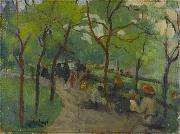 |
George Benjamin Luks
|
|
(August 13, 1867-October 29, 1933) was an American realist artist and illustrator. His vigorously painted genre paintings of urban subjects are examples of the Ashcan school in American art.
Luks was born in Williamsport, Pennsylvania, to Central European immigrants. His father was a physician and his mother was an amateur painter and musician.The Luks family (George, his parents and five siblings) eventually moved to Pottsville, in Southern Pennsylvania near the coal fields. In this setting, he learned at a young age the importance of compassion by watching how his parents helped the coal miners' families, and many believe that this is the reason why lower class New Yorkers were often Luks's subject matter. Luks studied at the Pennsylvania Academy of Fine Arts before he traveled though Europe where he attended several art schools. Later he went to Desseldorf where he lived with a distant relative, a retired lion-tamer. He abandoned Desseldorf for the more stimulating spheres of London and Paris. He then returned to Philadelphia in 1893 where he was an illustrator for the Philadelphia Press where he met John Sloan, William Glackens, and Everett Shinn. They would meet at the studio of Robert Henri, an artist who emphasized the depiction of ordinary life, shunning genteel subjects and painting quickly. The group became known as the "Philadelphia Five". In 1896, Luks moved to New York and began his art career there as the premier humorist artist for the New York World. During his time as an illustrator there, he lived with William Glackens.
|
|
|
|
|
|
 |
Gaspare Landi
|
|
Italian, 1756-1830,was an Italian painter of the Neoclassic period, active in Rome and his native city of Piacenza. He is said to have been a fun-loving younth, but in 1781 he procured a subsidy to study painting in Rome from patron and distant relative, Marquis Giambattista Landi. At age 25, he moved to Rome to work under Domenico Corvi and Pompeo Battoni. He is considered a rival of Vincenzo Camuccini. Two of his pictures were once in the Pinacoteca at Parma, Diomedes and Ulysses bearing off the Palladium (1783) and the Marriage of Abraham and Sarah. Above one of the altars in the church of the Santa Casa at Loreto there is a later work by this Landi showing the Madonna addolorata. A major work is his large canvas representing the fainting of Christ as he struggles along over the road to Calvary weighted down by the burden of the Cross, Lo Spasimo for San Giovanni at Piacenza. It hung opposite Vincenzo Camuccini's Presentation. Landi became a member of the Accademia di San Luca of Rome in 1805, professor of the theory of painting in 1812, and president of the Academy in 1817. He was also made a Chevalier of the Order of the Iron Crown, of the Order of San Giuseppe, and of a Neapolitan order. About 1820 he returned to Piacenza, intending to remain there, but soon tired of the monotonous existence of a provincial town, and in 1824 reestablished himself at Rome. His last work was an Assumption and was placed in the church of San Francesco di Paola, at Naples. He returned to Piacenza in 1829, where he died.
|
|
|
|
|
|
|
|
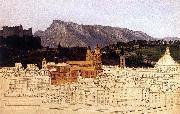 |
Friedrich Loos
|
|
was an Austrian Biedermeier style painter, etcher and lithographer. He was born in Graz on 29 October 1797. He studied at the Vienna Academy with Joseph Mössmer and also went on study tours through the Austrian Alpine regions. From 1835 to 1836 he lived in Vienna, and as of 1846 he sojourned in Rome. He then moved to Kiel, where he worked as a drawing teacher at the university as of 1863 and where he also died on 9 May 1890. In his pictures he emphasized light and color in order to loosen up his painting, as well as to harmonize and unite the details.
|
|
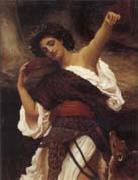 |
Frederick Leighton
|
|
1830-1896
He was an English painter and sculptor. His works depicted historical, biblical and classical subject matter. Leighton was born in Scarborough to a family in the import and export business. He was educated at University College School, London. He then received his artistic training on the European continent, first from Eduard Von Steinle and then from Giovanni Costa. When in Florence, aged 24, where he studied at the Accademia di Belle Arti, he painted the procession of the Cimabue Madonna through the Borgo Allegri. He lived in Paris from 1855 to 1859, where he met Ingres, Delacroix, Corot and Millet. Flaming JuneIn 1860, he moved to London, where he associated with the Pre-Raphaelites. He designed Elizabeth Barrett Browning's tomb for Robert Browning in the English Cemetery, Florence in 1861. In 1864 he became an associate of the Royal Academy and in 1878 he became its President (1878?C96). His 1877 sculpture, Athlete Wrestling with a Python, was considered at its time to inaugurate a renaissance in contemporary British sculpture, referred to as the New Sculpture. His paintings represented Britain at the great 1900 Paris Exhibition. Icarus and DaedalusLeighton was knighted at Windsor in 1878, and was created a baronet eight years later. He was the first painter to be given a peerage, in the New Year Honours List of 1896.
|
|
 |
Frederic,lord leighton,p.r.a.,r.w.s
|
|
1830-1896
English painter and sculptor. He studied in Florence. His first exhibited picture, which showed Cimabue's Madonna being carried through the streets of Florence, was purchased by Queen Victoria in 1855. Leighton was president of the Royal Academy from 1878 until his death.
|
|
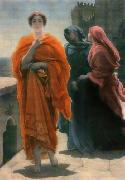 |
Frederic Leighton, 1st Baron Leighton
|
|
Frederic Leighton, 1st Baron Leighton PRA (3 December 1830 - 25 January 1896), known as Sir Frederic Leighton, Bt, between 1886 and 1896, was an English painter and sculptor. His works depicted historical, biblical and classical subject matter. Leighton was bearer of the shortest-lived peerage in history; after only one day his hereditary peerage ended with his death.
|
|
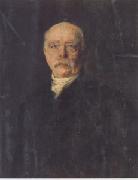 |
Franz von Lenbach
|
|
Shrobenhausen 1836-Munich 1904
German painter. The son of a master builder, he trained for his father's profession at the Kenigliche Landwirtschafts- und Gewerbeschule in Landshut, also working from 1851 in the sculpture studio of Anselm Sickinger (1807-73) in Munich. His elder brother, Karl August Lenbach (1828-47), had already become involved with painting, and it was through him that Franz Lenbach met Johann Baptist Hofner (1832-1913), an artist who had studied at the Akademie der Bildenden Kenste in Munich. They went on sketching expeditions together, and Hofner introduced him to plein-air painting. After spending two semesters at the Polytechnische Schule in Augsburg (1852-3), and some months in the studio of Albert Grefle (1807-89), a portrait painter in Munich, Lenbach entered the Akademie in Munich in 1854. In 1857 he attended the classes of Karl Theodor Piloty (later von Piloty), who was renowned for his history paintings. Lenbach produced his first important painting, the Angel Appearing to Hagar in the Desert (1858; destr.), while in this class, followed by Peasants Trying to Take Shelter from a Thunderstorm in a Chapel (1858; destr.; oil sketch, Schweinfurt, Samml. Schefer). The sale of this picture, together with a scholarship, enabled him to accompany Piloty on a journey to Rome with Ferdinand von Piloty (1828-95),
|
|
|
|
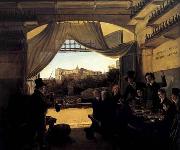 |
Franz Ludwig Catel
|
|
German Painter, 1778-1856,German painter. As a child, Catel helped carve small wooden figures in the toyshop owned by his father. With the encouragement of the printmaker Daniel Chodowiecki, Catel enrolled at the Berlin Kunstakademie, becoming a full member in 1806. In 1807, after already making a name for himself as a watercolourist and book illustrator, he began several years of study at the Acad?mie des Beaux-Arts in Paris, where his main subject was oil painting. In 1811 he moved to Italy, where he stayed for the rest of his life. Initially he wavered between Joseph Anton Koch's classically heroic style of landscape painting and the Romantic lyricism of the Nazarenes. Eventually he found that he could best exercise his technical ability, and most quickly achieve fame and fortune, by producing Italian landscapes. He specialized in Neapolitan scenes depicting festive folk customs; and such paintings proved popular with the mass of wealthy travellers who came to Italy after the Napoleonic Wars.
|
|
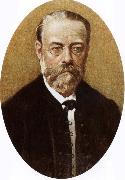 |
franz liszt
|
|
Period: Romantic (1820-1869)
Country: Hungary
Born: October 22, 1811 in Raiding
Died: July 31, 1886 in Bayreuth
Genres: Chamber Music, Choral Music, Concerto, Keyboard Music, Miscellaneous Music, Orchestral Music, Symphony, Vocal Music
|
|
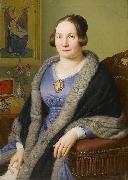 |
Franz Ittenbach
|
|
(April 18, 1813 - December 1, 1879) was a German religious painter from Königswinter, North Rhine-Westphalia, at the foot of the Drachenfels.
Ittenbach began his art education as a student of Kaufmann, then left to study under Franz Katz in Cologne. In 1832, Ittenbach became a pupil, at the age of 19, of the Desseldorf Academy, where he also received private lessons from its president, Schadow. He was a member of the Nazarene movement and associated himself mainly with three of his friends and fellow-students: Karl and Andreas Meller, and Ernst Deger. The four men travelled about in Germany, studying and painting together. From 1839 to 1842, Ittenbach lived in Italy. On his return, he stayed in Munich for some time. In 1849, he returned to Desseldorf. From 1859 until his death, he was a member of the artist club "Malkasten".
Ittenbach was exceedingly religious and persistently declined any commissions for mythological or pagan subjects. As a rule, he devoted his energies exclusively to church decoration. He would precede the execution of his greatest works with devout religious exercises, including confession and communion.
His finest paintings are said to be found at Bonn, in the church of St. Remigius, and in Breslau in a church dedicated to the same saint. There is also a remarkable "Holy Family" dated 1861, painted for Prince Liechtenstein in his private chapel near Vienna. Most of his other works can be found in various Catholic churches in Germany. His only important fresco was painted in 1844 in a church at Remagen.
Ittenbach was a popular painter in court circles, a member of most of the European academies, and the recipient of many medals and decorations. He painted a few portraits, but they were unimportant; his main work was his altar-pieces.
|
|
|
|
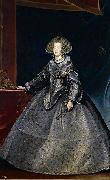 |
Frans Luycx
|
|
Frans Luycx.
Deutsch: Kaiser Ferdinand III. (1608-1657),
Brustbild.
Deutsch: um 1637/1638.
Medium. Deutsch.
|
|
|
|
|
|
|
|
|
| Wholesale China Oil Painting Wholesale Oil Painting China Xiamen Portrait Reproduction on canvas Chinese Oil Painting Wholesale USA Oil Painting |
|
|
|
|
|